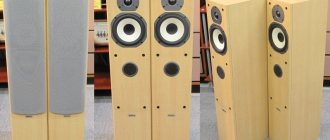The word “revolution” carries a much more powerful and ambiguous emotional message for Russians than for the inhabitants of the British Isles. However, the speakers that we will talk about today are truly radically different from their predecessors. Well, let's see exactly what progressive values the Scottish electroacoustic bands decided to convey to listeners.
The new generation of the Revolution family received the XT index and in appearance has become both more technocratic and more respectable. On the one hand, the silver trim on the speaker flanges has disappeared, revealing a six-point mounting system, and on the other, the base of the cabinet now rests on two thick chrome supports. Everything together looks harmonious and very stylish, and in addition, the unusual supporting structure has important functionality, which I will talk about a little later.
Revolution of sizes
The Revolution XT series has been enriched with a version of floor-standing speakers with eight-inch drivers (that’s what I tested) - such large speakers have not been seen in Tannoy’s affordable lines since the discontinuation of the Saturn family. By the way, the advanced version of the revolutionaries of the previous generation - Revolution Signature, like the old Saturns, had a bass reflex port facing forward, but the housings of the new speakers are much more interesting.
The bevel at the bottom of the cabinet is the outer part of the carefully calculated acoustic loading of the bass driver
The oblique cut at the base of the cabinet and the solid support platform create a gap that communicates with a separate chamber at the bottom of the cabinet. From the main volume, two bass reflex pipes are brought into it at once, so that the low-frequency head works on a rather complex acoustic design designed to improve the depth and uniformity of bass reproduction.
The speaker mounting flanges with chrome bolts are now visible, but the design only benefits from this
No less serious changes were made to the design of the proprietary Dual Concentric coaxial speakers, which (of course, with constant improvements) Tannoy has been using since 1947. So, during the current revolution, the most democratic modification of Dual Concentric has been transferred to the use of one magnet for both HF and midrange diffusers. The location of both voice coils in a single magnetic field made it possible to significantly improve their phase matching. In addition, this design move made it possible to move the tweeter dome forward, as a result of which the mid-frequency diffuser began to limit the dispersion of high frequencies less.
The tweeter changed color, acoustic design and even the shape of the diaphragm
The tweeter itself has also changed significantly: its waveguide has become much shorter, and the additional internal bell has been replaced with a phase-equalizing “bullet”. The tweeter dome is now made not of metal, but of polyesterimide film, and in fact it is no longer a dome - the radiation surface is ring-shaped. This design is called Torus Ogive, and its main purpose is, again, to expand the directionality of high frequencies and their better temporal coordination with the rest of the spectrum while maintaining the spatial accuracy characteristic of coaxial speakers.
This is not molded aluminum, but a cellulose diffuser with a concave cap, but it is almost impossible to guess this from its appearance
Like the younger brothers from the Mercury line, the mid/bass driver cones are made of cellulose fiber with a multi-layer coating that looks like aluminum.
In the lower part of the case there is a separate chamber with bass reflex pipes brought into it
The crossovers are tuned to frequencies of 250 Hz and 1.8 kHz; a second-order filter is used to separate the bass, and a first-order filter for the high frequencies. They use inductors with stacked metal cores, the internal wiring is made of silver-plated oxygen-free copper.
Body finishing: natural veneer in “dark walnut” or “oak” colors
The increased dimensions of the diffusers, a two-chamber bass reflex of a complex design - all these details indicate that the main point of effort for the developers of the new version of Revolution was the bass. And, I must say, the results of such tricks really make themselves felt.
Tannoy Revolution XT 8F speaker system test
The word “revolution” carries a much more powerful and ambiguous emotional message for Russians than for the inhabitants of the British Isles. However, the speakers that we will talk about today are truly radically different from their predecessors. Well, let's see exactly what progressive values the Scottish electroacoustic bands decided to convey to listeners. The new generation of the Revolution family received the XT index and in appearance has become both more technocratic and more respectable. On the one hand, the silver trim on the speaker flanges has disappeared, revealing a six-point mounting system, and on the other, the base of the cabinet now rests on two thick chrome supports. Everything together looks harmonious and very stylish, and in addition, the unusual supporting structure has important functionality, which I will talk about a little later. Revolution of sizes
The Revolution XT series has been enriched with a version of floor-standing speakers with eight-inch drivers (that’s what I tested) - such large speakers have not been seen in Tannoy’s affordable lines since the discontinuation of the Saturn family. By the way, the advanced version of the revolutionaries of the previous generation - Revolution Signature, like the old Saturns, had a bass reflex port facing forward, but the housings of the new speakers are much more interesting.
The bevel at the bottom of the cabinet is the outer part of the carefully calculated acoustic loading of the bass driver
The oblique cut at the base of the cabinet and the solid support platform create a gap that communicates with a separate chamber at the bottom of the cabinet. From the main volume, two bass reflex pipes are brought into it at once, so that the low-frequency head works on a rather complex acoustic design designed to improve the depth and uniformity of bass reproduction.
The speaker mounting flanges with chrome
bolts are now visible, but the design has only benefited from this.
No less serious changes have been made to the design of the proprietary Dual Concentric coaxial speakers, which (of course, with constant improvements) Tannoy has been using since 1947. So, during the current revolution, the most democratic modification of Dual Concentric has been transferred to the use of one magnet for both HF and midrange diffusers. The location of both voice coils in a single magnetic field made it possible to significantly improve their phase matching. In addition, this design move made it possible to move the tweeter dome forward, as a result of which the mid-frequency diffuser began to limit the dispersion of high frequencies less.
The tweeter changed color, acoustic design and even the shape of the diaphragm
The tweeter itself has also changed significantly: its waveguide has become much shorter, and the additional internal bell has been replaced with a phase-equalizing “bullet”. The tweeter dome is now made not of metal, but of polyesterimide film, and in fact it is no longer a dome - the radiation surface is ring-shaped. This design is called Torus Ogive, and its main purpose is, again, to expand the directionality of high frequencies and their better temporal coordination with the rest of the spectrum while maintaining the spatial accuracy characteristic of coaxial speakers.
This is not molded aluminum, but a cellulose cone
with a concave cap, but it is almost impossible to guess this from its appearance
. Like the younger brothers from the Mercury line, the mid/bass driver cones are made of cellulose fiber with a multi-layer coating that looks like aluminum.
In the lower part of the case there is a separate chamber
with bass reflex pipes brought into it.
The crossovers are tuned to frequencies of 250 Hz and 1.8 kHz, a second-order filter is used to separate the bass, and a first-order filter for the high frequencies. They use inductors with stacked metal cores, the internal wiring is made of silver-plated oxygen-free copper.
Body finishing: natural veneer in “dark walnut” or “oak” colors
The increased dimensions of the diffusers, a two-chamber bass reflex of a complex design - all these details indicate that the main point of effort for the developers of the new version of Revolution was the bass. And, I must say, the results of such tricks really make themselves felt.
Revolution of the squares
I started my audition with The Wood Brothers. The virtuoso playing of the double bass in “Ways not to lose” is practically not shielded by the bright parts of other instruments - an excellent indicator of the speed and timbral reliability of the bass. Paired with the McIntosh MA7900 amplifier, the speakers played this album very well. By “worthy” I mean dynamics and fullness, sufficient to immerse oneself in the atmosphere of a provincial American bar, and so that the person who heard the album for the first time does not torment himself with doubts: is this an electric guitar? Perhaps the strings of the double bass even felt a little hypertrophied - as if you were almost close to the instrument. However, after experimenting a little with the listening distance, the stage scale returned to normal.
The “bottom-front” direction of the bass
radiation gives greater freedom in placing the speakers in the room
. I must say that I listened to the acoustics in a room with an area of about fifty square meters, but the control, speed, and articulation of the bass did not seem dubious to me on any test track. True, the acoustic preparation of the room turned out to be extremely competent. As for the lower limit of the bass, everything, as you know, is learned by comparison, but for its class, the Revolution has clearly staked out its place among the leaders. The acoustic guitar sounded as detailed and pure as the double bass, without the timbre coloring that I remember from those same “Saturns” with polypropylene diffusers, which, by the way, at the dawn of my foggy youth I listened to for quite a long time.
Different widths of the front and rear panels are an excellent
way to combat internal resonances.
To shake off the numbness of the American outback, I put on The Offsring. "Americana" is an album with a fast, constantly changing tempo, but the speakers can keep up with it without any problems. In tracks with a complex spectrum, individual instruments are picked out by the ear without much effort. Moreover, at times there is a feeling that “Revolutionaries” emphasize the very hooligan essence of punk rock - they are bright, dynamic, fast, and sometimes especially tricky parts tend to skip without slowing down the rhythm and without focusing the listener’s attention on super-subtle nuances.
With a height of about 108 cm, each column weighs almost 20 kilograms
The third test was the recording of Emeli Sande's concert at London's Royal Albert Hall. Here the acoustics only confirmed the reputation that had begun to take shape. Emily's bright, rich overtones vocals (also Scottish, by the way) sounded unusually open and dynamic for speakers in this price category; relief and volume were felt in the instrumental parts. The musical scene is detailed and expanded, and to get it in this form, you don’t have to carefully select a place and turn your head in search of the best position. The developers really managed to significantly expand the radiation pattern.
Revolution of the Aristocrats
There is an opinion that Macintoshes play well with Tannoy speakers from the upper price division, but in our case, the power capacity of the 200-watt flagship turned out to be just right. Despite the fairly high sensitivity (91 dB/m), complex acoustic design requires strict control, but the result clearly justifies the effort.
Gold-plated terminals allow bi-wiring connections
Judging by the nature of the sound, the slight softening of the sound picture characteristic of McIntosh came in very handy - without it, the Revolution XT would have behaved even a little more aggressively.
In this they reminded me vividly of the young scion of a respected British family: he studies at Eton, but between lectures on the history of classical music he listens to The Clash and Dropkicks Murphys. In terms of depth of space and finesse of timbre development, the new Revolutions, of course, cannot compete with the older representatives of the Tannoy family, but they have energy and drive, without which life simply disappears from many modern genres. However, even on the most outrageous riffs, they will never slide into crumpledness and sloppiness - the breed! Features:
Acoustics are not capricious, but require a conscious approach to choosing amplification.
Advantages:
Impressive dynamics and depth of bass, openness of vocals and high detail in almost the entire reproduced range.
Source: www.stereo.ru
Go to the manufacturer's catalog
Revolution of the squares
I started my audition with The Wood Brothers. The virtuoso playing of the double bass in “Ways not to lose” is practically not shielded by the bright parts of other instruments - an excellent indicator of the speed and timbral reliability of the bass. Paired with the McIntosh MA7900 amplifier, the speakers played this album very well. By “worthy” I mean dynamics and fullness, sufficient to immerse oneself in the atmosphere of a provincial American bar, and so that the person who heard the album for the first time does not torment himself with doubts: is this an electric guitar? Perhaps the strings of the double bass even felt a little hypertrophied - as if you were almost close to the instrument. However, after experimenting a little with the listening distance, the stage scale returned to normal.
“Lower-front” directionality of bass radiation gives greater freedom in placing speakers in the room
I must say that I listened to the acoustics in a room with an area of about fifty square meters, but the control, speed, and articulation of the bass on not a single test track seemed dubious to me. True, the acoustic preparation of the room turned out to be extremely competent. As for the lower limit of the bass, everything, as you know, is learned by comparison, but for its class, the Revolution has clearly staked out its place among the leaders.
The acoustic guitar sounded as detailed and pure as the double bass, without the timbre coloring that I remember from those same “Saturns” with polypropylene diffusers, which, by the way, at the dawn of my foggy youth I listened to for quite a long time.
Different widths of the front and rear panels are an excellent way to combat internal resonances
To shake off the numbness of the American outback, I put on The Offsring. "Americana" is an album with a fast, constantly changing tempo, but the speakers can keep up with it without any problems. In tracks with a complex spectrum, individual instruments are picked out by the ear without much effort. Moreover, at times there is a feeling that “Revolutionaries” emphasize the very hooligan essence of punk rock - they are bright, dynamic, fast, and sometimes especially tricky parts tend to skip without slowing down the rhythm and without focusing the listener’s attention on super-subtle nuances.
With a height of about 108 cm, each column weighs almost 20 kilograms
The third test was the recording of Emeli Sande's concert at London's Royal Albert Hall. Here the acoustics only confirmed the reputation that had begun to take shape. Emily's bright, rich overtones vocals (also Scottish, by the way) sounded unusually open and dynamic for speakers in this price category; relief and volume were felt in the instrumental parts. The musical scene is detailed and expanded, and to get it in this form, you don’t have to carefully select a place and turn your head in search of the best position. The developers really managed to significantly expand the radiation pattern.









